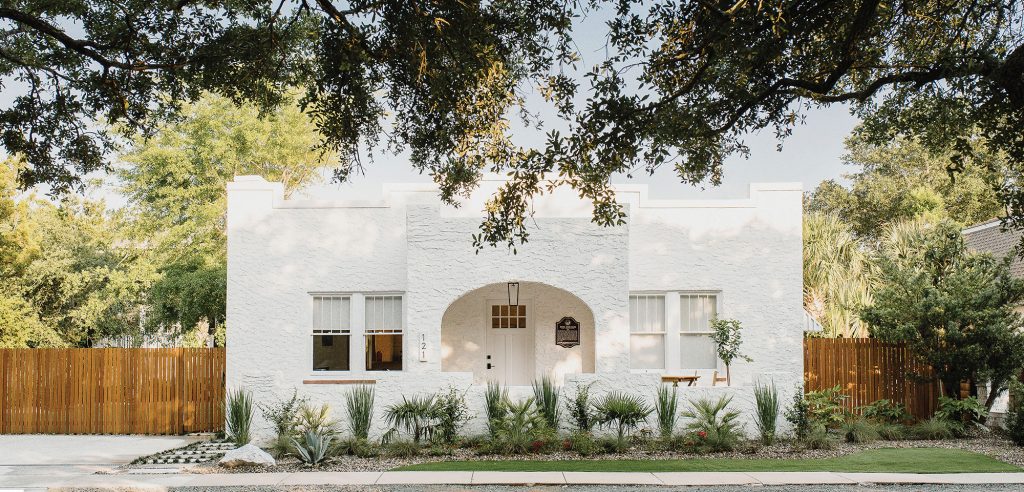Back to the Future
Renovating a historic Wrightsville Beach cottage
BY Marimar McNaughton

Homeowners Ross and Bryce Tomaselli collaborated with builder Tanner Konrady to renovate, retrofit and reinterpret the 1928 Shore Acres model home on Harbor Island for year-round 21st-century living. Little did they suspect they were following in the footsteps of others who came before them nearly 100 years ago.
“My mom was the first to notice the house was for sale,” says Ross Tomaselli, who grew up in the Airlie Road neighborhood near Wrightsville Sound as the son of Kate and Lumina Station developer Joel Tomaselli. “We really wanted to be on Wrightsville Beach. Real estate is at a premium over here.”
The search began and ended quickly.
“It was kind of serendipity that this popped up on the market. We were in the right place at the right time,” Tomaselli says.
Closing in November 2019 at just shy of $700,000, the .16-acre property was reasonably priced by Wrightsville standards. The tiny 1,617-square foot house captivated Tomaselli’s growing interest in historic preservation, attracting him to the uniqueness of the architecture.
To renovate the home’s interior, Realtor Marcello Caliva suggested Tomaselli contact Wrightsville Beach native Tanner Konrady, son of custom home builder Ralph Konrady, to lead the renovation and remodeling team.
“We had many mutual connections, but we had not officially met,” Konrady says.
Growing up on Schloss Street, at the south end of the beach, Konrady had worked for his dad as far back as his memory travels, and officially joined Konrady & Son in 2006.
Not long after the 2019 closing, Tomaselli and Konrady met for the first time at 121 Live Oak Drive.
“I knew nothing about that house from its history perspective,” Konrady says. “Ross was there, and his mom was there. They gave me a background of the house and explained what they wanted to do. It was a project that we all knew was going to evolve.”
In January 2020, 121 Live Oak LLC was granted a permit for a $100,000 renovation. Not long after, the interior demolition began.
“I’m really into historic buildings,” Tomaselli says. “History is something that can’t be replicated, just preserved.”
In the process of preserving the 1920s-era Shore Acres model home and retrofitting the interior for modern living for him and his wife, Bryce, he was schooled on the challenges. Some of those hurdles were placed by the Town of Wrightsville Beach Planning Department and its Historic Landmark Commission, which conferred landmark status for the property in 2007.
The commission mandated no exterior changes be made to the facade of the structure — inclusive of additions — but allowed widespread changes to the interior. Originally, the living and dining rooms were separated by French doors. To accommodate the couple’s desire for an open floorplan, the teammates dismantled the doors and set them aside to repurpose later.
Three additional structural beams were needed before interior walls could be removed. Those additions required the removal of plaster walls and ceilings. The biggest surprise revealed two-by-eight ceiling joists and inlaid tongue-and-groove wood panels. Exposing the original beams added volume to the interior. Authentic red oak floors were refinished.
The kitchen was expanded by sacrificing a portion of the third bedroom. What footprint remained was claimed by Bryce Tomaselli for her home office, where the Wilmington native works remotely as a PPD nurse.
Konrady says it was obvious the home had been renovated multiple times in the 92 years it had been occupied. Electrical and plumbing were not far behind modern systems, he observed, yet the systems needed to be moved to make the most efficient use of the space.
A closet in the master bedroom was removed, creating a two-foot alcove that functions as a headboard. An original ironclad clawfoot tub that did not fit into the master plan was given to friends Alyssa and Jordan Ait and is now a centerpiece in their Mother of Wild Flower House in Porters Neck. The upfit bath features an open shower with a soaking rain head. The one room that didn’t change much is the guest room.
The interior palette is blond with white walls and upholstered seating. The wood finish of the floors is echoed in furnishings that blend two aesthetics into one unique style.
“My wife lived in Australia for a year before I met her,” Tomaselli says. “Because of that, I’ve become fascinated with Australian design.”
His own affinity for Scandinavian lines led to a new coastal hybrid embracing an eclectic mix blending both.
Tastemakers and young preservationists in their own right, Nicole Alvarez and Matt Tomasulo, owners of the Guest House boutique hotel in Raleigh, were helpful in appointing the rooms.
By trimming the four-car driveway to two and moving around some fences, the Tomasellis gifted themselves a bigger backyard. By mid-June 2020, the final touches to the landscaping were complete.
Adding a deck expanded their living from indoors to out for the enjoyment of all inhabitants, including their two Australian shepherds, Juliet and Romeo.
New Faces of Preservation
“I think what I really love, most people would have bought this property and torn it down to build something new,” Konrady says, “but Ross and his mom were so in tune to the character of the house. All they wanted to do was to preserve and enhance it.”
Likewise, Tomaselli was appreciative of working with the builder.
“Tanner has an incredible collection of subs,” Tomaselli says. “My appreciation for craftsmanship has grown tremendously. He made this project so enjoyable, but I think the thing I’m most excited about is preserving a special piece of Wrightsville Beach history.”
The home isn’t their only project. They teamed up to retrofit another Tomaselli investment at 84 Waynick Blvd., once the site of the town’s only laundromat. The fashion boutique Hallelu occupies the ground level while the Tomaselli-Konrady team is rehabbing the upstairs apartment with Alvarez and Tomasulo of Guest House. When finished this summer, the apartment looking over Banks Channel will be a short-term rental.
“An Ideal Summer Colony and Winter Haven”
The year was 1927. Approximately 70 acres of infilled marsh and upland hummock islands owned by the Shore Acres Company sold for $400,000. The following summer, new owners Oliver T. Wallace, president, and Richard L. Player, secretary-treasurer, along with developer Roger Moore, announced in The Wilmington Morning Star “high-pressure water, gas, electricity, concrete sidewalks and streets.”
They invited the public to attend a real estate auction, during which 30 contiguous lots were offered. The lots, although located only eight miles from downtown Wilmington, were conceived primarily as locations for summer or vacation homes.
Fifteen lots sold in one day at prices ranging from $1,600 to $3,000. Buyers represented members of Wilmington’s elite, prominent young men of business and enterprise, many of them scions of the city’s first families: John Leland Becton; Herbert Bluethenthal; B.B. Cameron; Wayne Alexander Fonvielle; Clayton Giles; John R. Hanby; J. O. Hinton; H. Lacy Hunt; Fred Albert Matthes; Horace Pearsall; Mrs. John Snyder; William Struthers Jr.; E.T. Taylor; and Walker Taylor Jr.
Even though the early pioneers likely intended to build vacation homes or retreats, the Shore Acres Company encouraged year-round living by enticing city dwellers to visit a new model home — the first to be built on Harbor Island — at 121 Live Oak Drive. The floorplan included three bedrooms, a living room, a dining room, a kitchen, tiled baths, built-in showers, hardwood floors, front and back porches, and a garden.
The architectural style of the model house represented a departure from the antebellum and Victorian styles popular in downtown Wilmington. The new idiom expressed a growing national trend, embracing the Mission Style. Minted in California where its origins were inspired by Hispanic — specifically Spanish Mediterranean — or Moorish architecture, the revival gained traction between 1890 and 1915.
The most notable element of this design type is the use of terra cotta clay tiles for roofing and masonry or stucco exteriors. Other details include cantilevered or pent roofs over an arcaded entrance, parapet walls, viga downspouts, rounded arched windows and asymmetric facades and floor plans.
From these elements, the designers of the Shore Acres model home borrowed a stepped parapet wall facade, an arcaded entry, arched windows, and stucco exteriors. The only other extant example of the Mission Style residence is located on Causeway Drive. Now zoned commercial, the structure has operated in the past decade as a real estate office, a coffee shop, a surf annex, and a poke bowl eatery.
